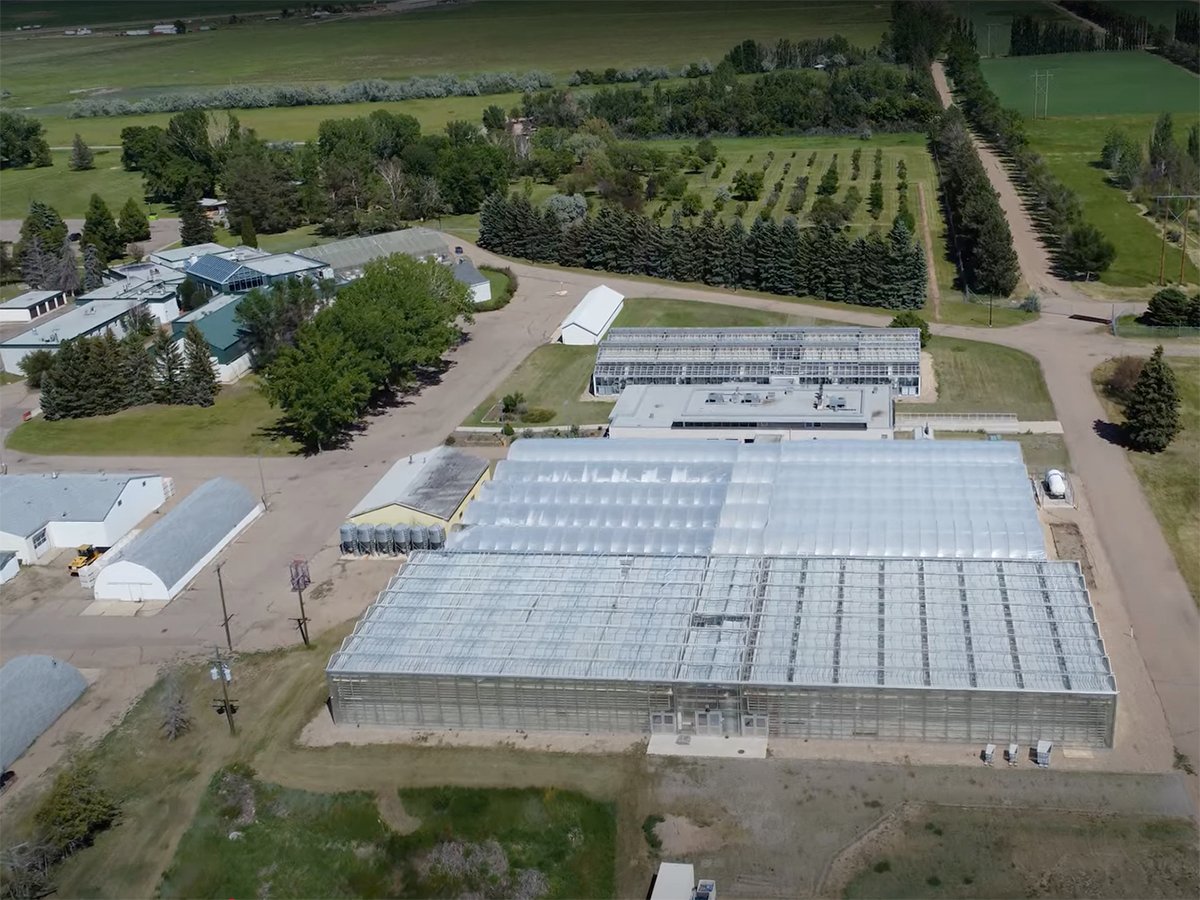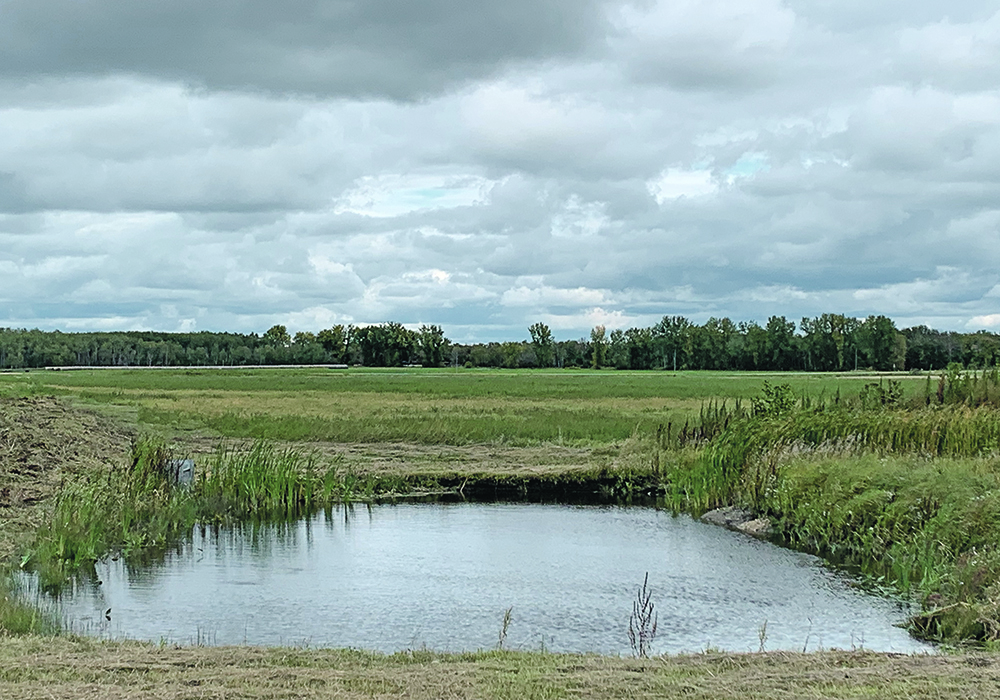The pyramids are impressive. The Hoover Dam takes away one’s breath.
Even here in Manitoba, the giant Red River diversion that occasionally saves Winnipeg from flooding, known to those with historical memory as Duff’s Ditch and as the Floodway to most, fills the eye with splendour any politician would love to preen before.
That isn’t true of the water retention structures on Neil Claringbould’s pastures east of Emerson, Man., just north of the U.S. border.
The one he was standing near on a grey day of autumn chill when I visited is quite unimpressive. It looks like a modest dugout along a small stream with a low earthen crossing providing one side of the pond with a low, sloping barrier. The forage-covered earth wall contains a pipe that allows runoff water to pass through once it has filled the dugout. That pipe can be blocked if the farmer wants to hold back more water.
Read Also

Alberta crop diversification centres receive funding
$5.2 million of provincial funding pumped into crop diversity research centres
“It looks like it’s been here for years,” observed forage researcher May Elsinger of Agriculture Canada, who was visiting the site with local watershed officials, fellow Ag Canada applied science folks and a couple of curious local farmers.
That was music to the ears of Joey Pankiw, the interim manager for the Seine Rat Roseau Watershed District, who has been involved with water retention structures like this as part of the Living Labs program.
In fact, the mini-project on Claringbould‘s land has been here less than a year. At last year’s freeze-up it was being put together with clumps of frozen soil and looked messy and clumpy.
“It’s hard to tell there’s a water retention there,” said Pankiw, standing a couple of dozen metres from the still water, the gentle, green slope and the bullrushes that filled the channel leading to the dugout.
“That’s what we strive for: to blend in a little bit to the landscape to make it natural infrastructure.”
This water retention pond isn’t the only one in the area. There are more than 10 on nearby farms, but they don’t draw much attention. Perhaps that’s why this environmental improvement project is succeeding. It’s not trying to do too much in any one place but is part of a network of small-scale projects that end up helping every person along the waterway, from the farmer to downstream neighbours to people along the Red River to those who care about Lake Winnipeg.
A big dam could hold back water from this often-saturated area, keeping back floodwaters and sediments, but building one could become a nightmare of conflicting interests, protests, politics and outrage, likely ending in years-long delays that might result in nothing being completed. These little projects are cheap, get done fast, and don’t set neighbour against neighbour.
In fact, they tend to make neighbours want to join.
“It’s easy to do when everybody knows each other,” said Dorothea Gregoire of the watershed district. Neighbours talk and share ideas. Good ones that work, seem doable and don’t cause conflicts, catch on. Interest spreads.
It’s not the sort of thing that tends to create high-profile ribbon cuttings among luminaries, but megaprojects have often gone bad in recent years.
“Once you start to have huge infrastructure, you have huge potential for something to go wrong, someone needs to manage it, it can have bigger impacts,” said Gregoire.
Rural Western Canada is littered with large projects mired in controversy and delays, be they pipelines, flood management channels, mines or powerlines. It’s become so difficult to build big that many people don’t want to think of building anything at all.
Networks of modest developments can have major impacts that change the world, but few stop and notice. They can be revolutionary, but they create a transformed world that just seems to evolve in the background, undramatically.
Marc Levinson explored that puzzling truth in the introduction to his epic history of the development of the container shipping business, The Box. Container shipping transformed world trade and to a significant degree was responsible for globalization itself, but nobody had bothered to tell its history. Container shipping scarcely existed in the 1960s.
“I think academics ignored the container for so long because it seemed so prosaic…. It was too simple to be worth much study,” he wrote.
Yet container trains many kilometres long dominate our railways, our roads are clogged with container-hauling trucks, our ports are filled with mountainous container ships and our stores are filled with goods brought in containers from every corner of the Earth.
The container shipping revolution was the transformation of a system, not the creation of a remarkable technology. It might not seem that impressive, regardless of its impact. It’s a psychological blind spot for many.
A researcher I recently spoke with had noticed a similar blind spot. Important and original work their lab was doing had seemed to their organization like a great story to tell. But when the research was found to be using simple methods involving little radical technology, interest in telling that story faded. The knowledge and understanding coming from the research might be vital, but without technological bigness and boldness to sell it, the story sagged.
However, as Gregoire explained, the low-key nature of innovation like that in Claringbould’s pond is what allows these radical innovations to quietly spread through a farming community. People talk, ideas spread, things get done. The world gets a little bit better, piece by piece.
Farming communities don’t need things to be big and bold.
If something small works and helps; that’s good.
Nobody else needs to notice and maybe it’s better if they don’t.
















